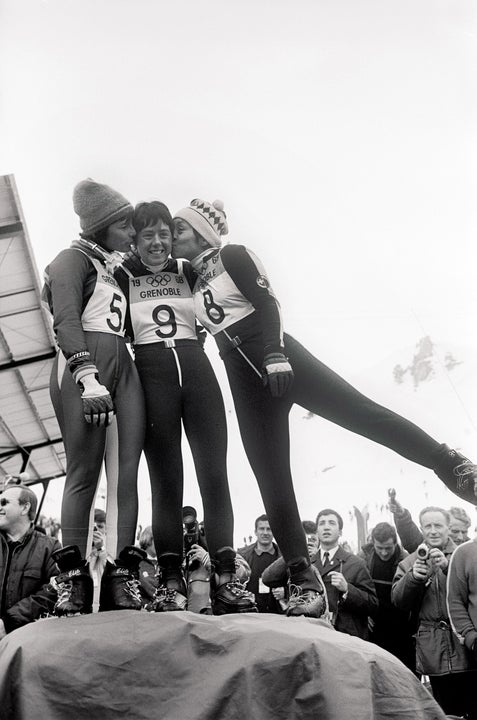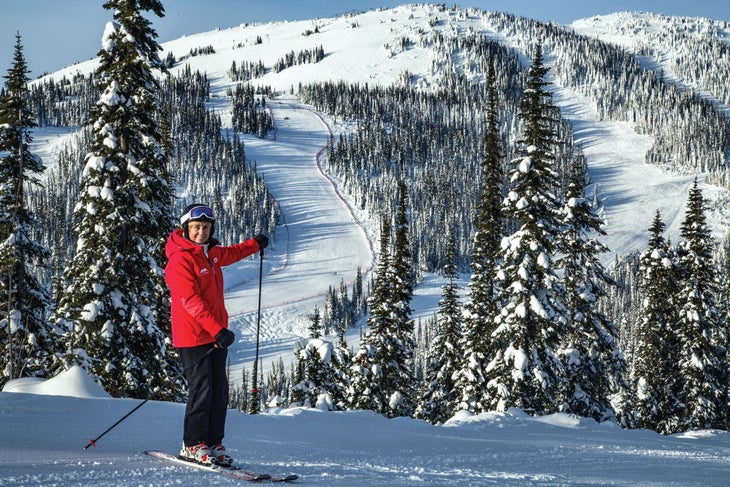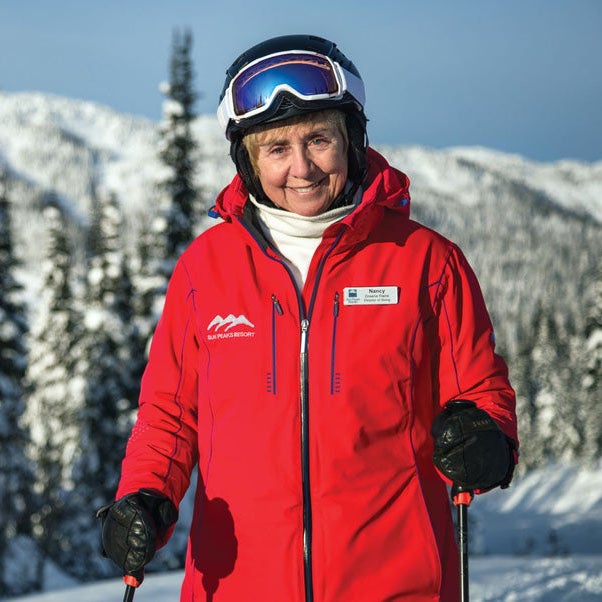I’ll be honest: when I first learned that Nancy Greene Raine would be my host for a day of skiing, I had to Google her to find out who she was. It didn’t take long to figure out she was big time. Thousands of search results returned snippets detailing Greene’s illustrious ski-racing career and her term as a senator for British Columbia, along with hundreds of black-and-white photos of a young Greene in action and more recent headshots of a woman with cropped hair and a charming, crooked smile.
On our appointed ski day, I’m told I’ll find Greene outside the Sun Peaks Sports Center, to just look for her signature red jacket. I find her easily enough—her outerwear doesn’t give her away as much as her Rossignol World Cup ski boots. Greene picks me out just as easily, and before any formal introductions are made, she hollers a hearty “You must be Jenny. Let’s go!” and starts skating powerfully toward the lift line. Despite her slight frame, Greene’s longtime racing nickname, Tiger, suits her perfectly.
Everywhere we go, lifties and locals alike greet her, and she does the same. Sun Peaks visitors do double-takes. It’s clear that Greene, recipient of dozens of prestigious national awards and Canada’s Female Athlete of the 20th Century, is a national treasure.
It’s a huge honor, Greene admits. But one well-bestowed considering her two Olympic medals, two World Cup titles, six Canadian Championship titles, and three U.S. Championship titles, all collected while on the Canadian National Alpine Ski Team from 1959 through 1968, when skiing as we know it was still in its infancy.

“My dad and mum were keen skiers even back in the day before there were really any lifts,” Greene explains. In 1947, when Greene was just three years old, her parents moved the family from Ottawa to Rossland, BC, to be in the mountains and close to skiing. “During that time, there was lots happening in skiing. Sun Valley started up just before the war, so some people from Rossland who had been to Sun Valley started talking about building a ski lift. My parents helped put together the financing to develop Red Mountain.”
As a result, Greene and her five siblings were raised on the ski slopes. By the age of 16, she and her older sister Elizabeth were on their way to the 1960 Winter Olympics in Squaw Valley, California.
“I was lucky that I got to room with Anne Heggtveit during those Olympics,” Greene remembers. “She was a veteran on the team and ended up winning the gold medal in slalom in Squaw. She was really good to me—mentored me and took me under her wing. When she won gold, I knew from rooming with her that if she could do it, I could do it. She didn’t have anything magical—she still had to wash her socks in the sink at night, just like me.”
Greene didn’t win any medals at the Squaw Valley Olympics, but in 1967 she became the first female overall World Cup champion after beating France’s Marielle Goitschel in the final giant slalom of the inaugural Alpine World Cup. The following year, she won the ladies’ overall World Cup title again, a victory that came hot on the heels of an Olympic gold medal in giant slalom and Olympic silver in slalom at the 1968 Grenoble Olympics.
To this day, Greene is still the only Canadian—male or female—to have won the World Cup overall title, firmly cementing her name in the Canadian Ski Hall of Fame. But Greene’s athletic achievements are just a portion of her contributions to Canadian skiing.
After retiring from ski racing at the age of 24, Greene married Al Raine, the Canadian Ski Team head coach turned private consultant to the British Columbia Ministry of Lands, responsible for the development of ski areas across the province. The pair were integral in the development of Blackcomb and the planning of Whistler Village, where in 1986 they built Nancy Greene’s Olympic Lodge, Whistler’s first hotel. They then turned their attention to Sun Peaks in the Interior BC, moving to the fledgling resort in 1995 to help develop the ski area into Canada’s second-largest resort. Along the way, Greene helped establish the Nancy Greene Ski League, a national grassroots ski-racing development program that’s been supporting youngsters in the sport for more than 30 years.
Related:

“When I first started out racing, my ski club went around knocking on doors around town, asking people to donate so I could go to Europe to race,” Greene recalls. “That’s one reason I’ve always felt responsible to give back to the sport, because I couldn’t have done it without support.”
In her 60-plus-year ski career, Greene has accomplished more than most of us will accomplish in ten lifetimes. The real kicker: she still notches more than 100 ski days a year.
I’d like to say I was able to keep up with Greene while she skied me around the resort, but her preferred method of skiing is still the tuck, and truth be told, I ended up chasing her down each run. “I always did like downhill the best,” she confesses. “I like the speed.”


